-
Mail us
contact@tiger-transformer.com -
Phone us
(+86)15655168738
Mail us
contact@tiger-transformer.comPhone us
(+86)156551687380 Introduction
Oil-immersed transformers are widely used due to their good insulation strength, strong heat transfer performance and low engineering cost. They can solve the problem of heat dissipation and work of large space heat pipes. High voltage insulation problem. However, the common oil leakage problem in the operation of oil-immersed transformers seriously endangers the operational safety of the transformer [1-3].
Transformer oil leakage will pose a serious threat to the safe operation of the transformer [4].
(1) If the transformer leaks oil for a long time or leaks a large amount of oil, the amount of oil in the oil conservator will be insufficient. When the oil level of the oil conservator drops too much during operation, it will cause the gas relay to malfunction. When the transformer is severely short of oil and the internal windings are exposed, the insulation layer will be destroyed, and even a thermal breakdown accident may occur, causing the transformer to be out of service and endangering the reliable power supply of the power project.
(2) Oil leakage from the transformer can easily cause water to enter, causing moisture to return inside the transformer.
(3) The oil leakage location of the transformer is very easy to adhere to dust, causing oil stains to adhere to a large area on the surface, which greatly damages the appearance brand image and leads to repair difficulty.
(4) Leaking aviation hydraulic oil will cause a waste of water resources and pollute the environment [5-7].
Therefore, the problem of transformer oil leakage must attract the attention of substation maintenance personnel. If the sealing performance of the casing is poor during the daily operation and maintenance of the main transformer, it may cause oil leakage or internal moisture failure, affecting The transformer operates safely. This article lists two examples of equipment defects caused by poor sealing performance of 500 kV transformer bushings.
1 Fault Example 1: Serious oil leakage from phase C high voltage casing of #1 main transformer of a 500 kV power plant
1.1 Main transformer and bushing conditions
The main transformer has a capacity of 240,000 kVA and was put into operation in December 1997. Its high-voltage bushing model is LZZB1-10 600/5A.
1.2 Defect handling situation
During a special equipment inspection in September 2016, it was found that the #1 main transformer C-phase casing of the power plant was short of oil. There are traces of oil leakage around the end screen of the tube. When the test personnel performed an infrared temperature measurement on the #1 main transformer, they found that the C-phase casing oil level indicator showed no oil. The infrared thermal image pattern is shown in Figure 1. At this time, the ambient temperature is 29 ℃, the relative humidity is 70%, and the load current is 46.6 A. According to Figure 1, it can be seen that the temperature distribution in the three-phase casing oil chamber is inconsistent. The temperature in the C-phase casing oil chamber is lower, and its distribution range is 35.7~36.9 ℃, while the normal B-phase temperature distribution range is 37.4~38 ℃. Diagnosis Because the casing is short of oil, the drop in oil level causes the temperature of phase C to be low. After close follow-up, on October 30, 2016, the #1 main transformer C-phase casing was subjected to a power outage to eliminate defects. After processing, the oil leakage inspection, test data and live detection were all normal, and the defects were eliminated.
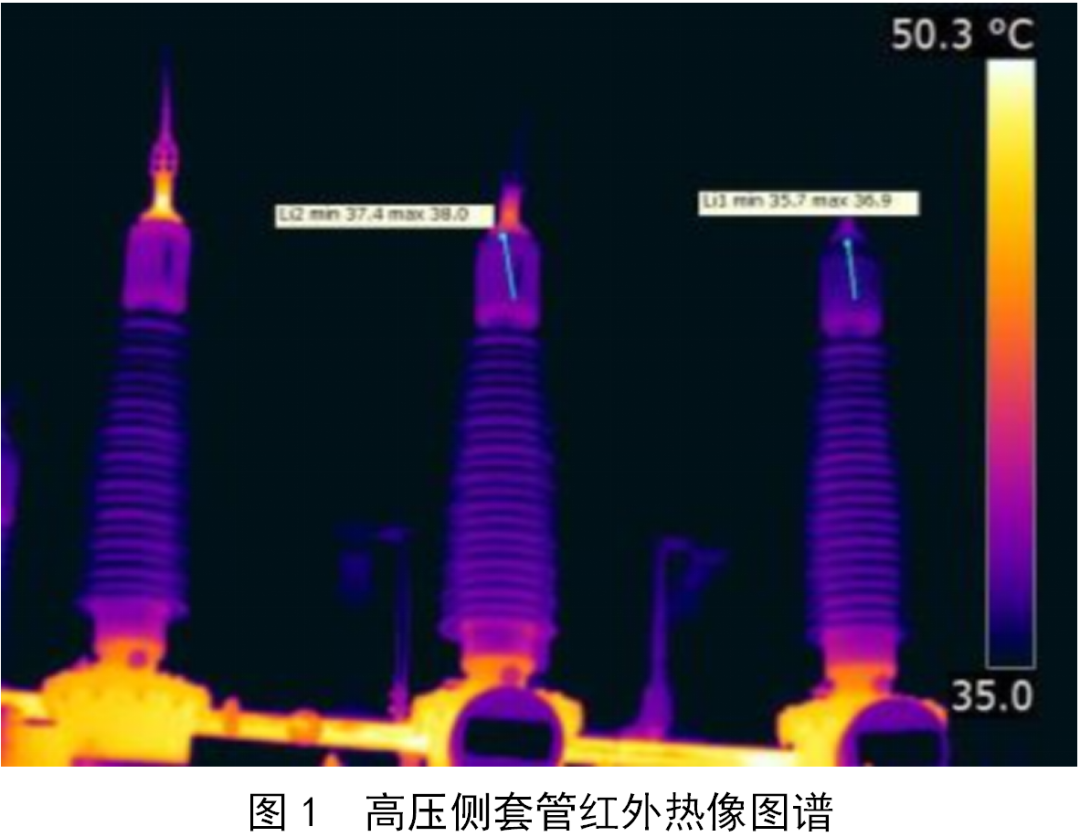
1.3 Inspection and Test
1.3.1 Bushing Inspection
In order to find the oil leakage point of the main transformer casing, during the power outage, maintenance personnel carried out inspection on the casing. After a comprehensive inspection, it was found that the oil leakage near the last screen was the most serious. After opening the small grounding cover of the last screen, new oil continued to flow out from the last screen, and the terminal nut of the last screen was loose, as shown in Figure 2 shown. Then tighten the terminal nut of the end screen and observe that there is no continued oil leakage after a period of time.
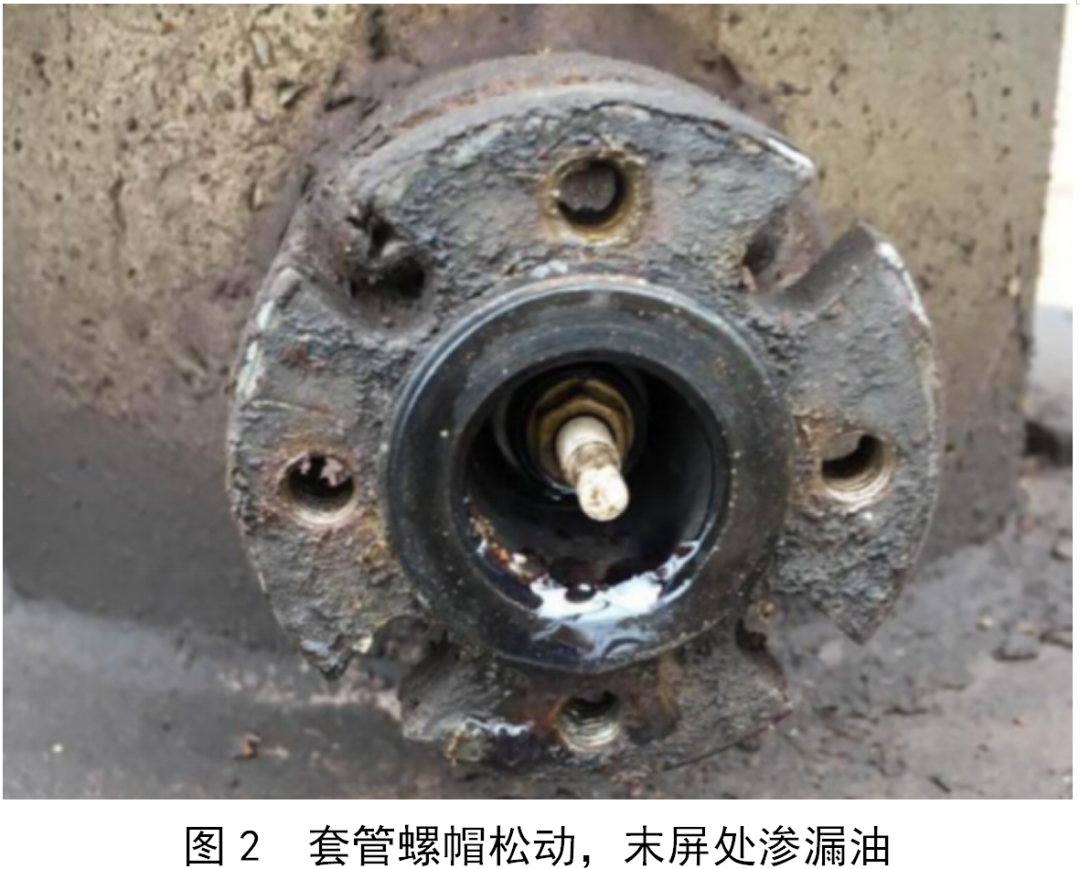
1.3 .2 Bushing test and treatment
In order to check whether the insulating oil of the leaking bushing is qualified, the oil samples of the B and C phase bushings of the #1 main transformer were taken for comparative analysis. The test data are shown in Table 1. Show.

From From the oil chromatography test data in Table 1, it can be seen that the insulating oil test data of phase B and phase C casings are both within the qualified range, but the H2 and CH4 contents of phase C casing are significantly greater than those of phase B, which are close to the attention value. Therefore, it is judged that C The phase casing is slightly damp inside due to oil leakage due to respiration. Immediately, the C-phase casing was subjected to cyclic oil filtering treatment. After multiple oil changes, the oil level of the C-phase casing was replenished to the normal level. After leaving it alone for 24 hours, the oil chromatography test was passed again. After continuous observation for two days, the casing oil level remained stable and there was no oil leakage.
Before and after replacing the casing oil, the C-phase casing electrical test was carried out and compared with the test data of the previous maintenance cycle. The test data are shown in Table 2. Show.

Above The data are all within the qualified range. In the case of oil shortage, the capacitance value of the bushing is reduced to a certain extent, but the test data is still within the standard value. It can be determined from this that the oil leakage of the C-phase casing of the main transformer was caused by loose bolts at the terminal of the last screen and poor sealing.
2 Fault Example 2: The neutral point casing of #2 main transformer in a 500 kV power plant is damp
2.1 Main transformer and casing conditions
The main transformer has a capacity of 240,000 kVA and was put into operation in 2003. Its high-voltage bushing model is LZZB1-10 600/5A.
2.2 Defect handling situation
In July 2018, the power plant carried out a routine test of the #2 main transformer. The weather was sunny at that time, the humidity was 65%, the ambient temperature was 29°C, and the upper oil temperature was 33°C. According to the test process, the winding DC resistance, tap changer operating characteristics, and winding low voltage impedance tests were first conducted, and all were qualified. However, the insulation resistance and leakage current tests of the high-voltage bushing and winding to low voltage and ground were not satisfactory. qualified. The leakage current of the outer porcelain sleeve of the high-voltage bushing to ground is 12 μA at 40 kV DC voltage, and the insulation resistance value reaches 20 000 MΩ. The data is shown in Table 3.
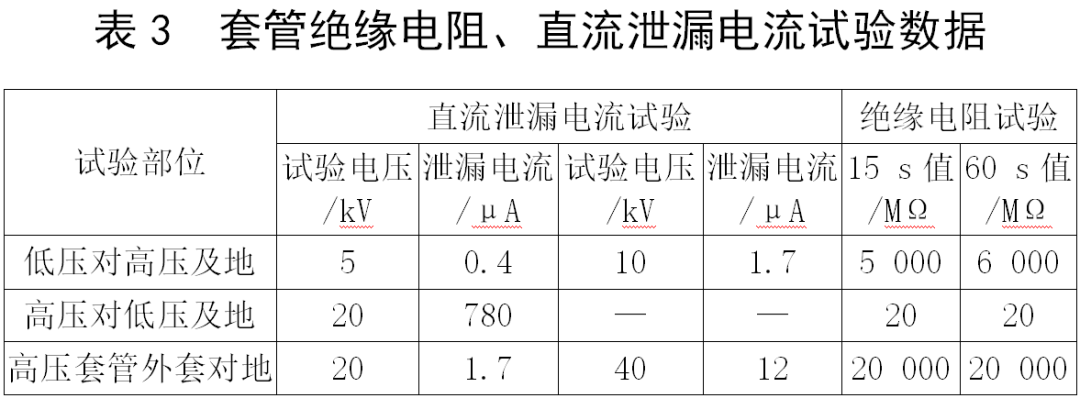
Experiment The data shows that the external insulation performance of the high and low voltage bushings of the transformer is normal, but there are defects in the insulation of the high voltage side bushing of the main transformer. Subsequently, relevant electrical tests were carried out on the main transformer windings and bushings. The test data are shown in Table 4.
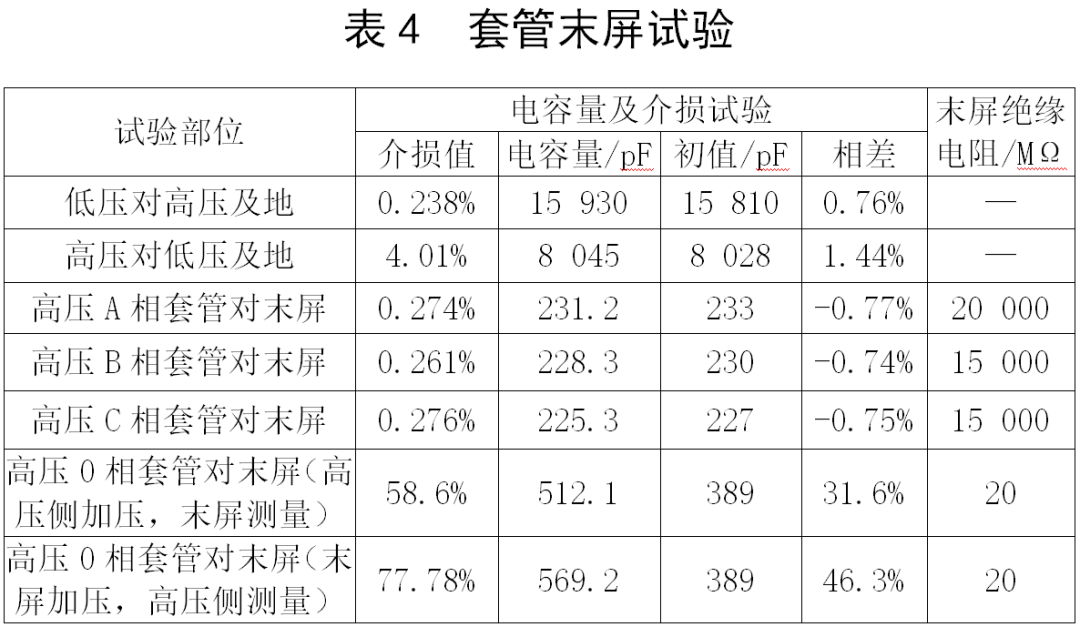
Experiment It further shows that the low-voltage side insulation test is qualified, but the high-voltage winding and bushing dielectric loss value, high-voltage 0-phase bushing capacitance and dielectric loss value are all unqualified. Analyze the influence of high-voltage 0-phase bushing on the dielectric loss value of high-voltage winding and bushing, and perform theoretical calculation:
Cl×tgl%=C total×tg total%-C0×tg0%
tg1%= (4.01%×8045-58.6%×512.1)/(8045-512.1)≈0.299%
In the formula: C1 and tg1% are the high-voltage windings after excluding the influence of the 0-phase bushing. Capacitance and dielectric loss values.
Analysis and calculation show that after excluding the influence of the 0-phase bushing, the high-voltage winding capacitance and dielectric loss values are qualified.
Take oil samples from the transformer body and high-voltage bushings for dissolved gas chromatography and moisture analysis in the oil. The test results show that the body oil and A, B, and C three-phase bushing oil samples are qualified, and the 0-phase bushing The hydrogen and moisture in the oil sample exceed the standards. In order to more comprehensively test the insulation performance of the transformer and confirm the analysis and judgment conclusions, it was decided to conduct a partial discharge test after grounding the defective phase high voltage 0 phase. The partial discharge test results show that the partial discharge amount under the three-phase voltage of 1.3 times Um/√3 is less than 100 pC.
Based on the above test results, it was found that the neutral point bushing of the main transformer had severe insulation defects caused by moisture, and the insulation performance of the transformer body and other components was normal. After replacing the new neutral point bushing, the main transformer passed the test and the power supply was restored.
The neutral point casing was disassembled and analyzed in the maintenance workshop. After disassembly, it was found that water and moisture had entered the inside of the casing, as shown in Figure 3. The reason for the water intrusion into the casing was the deformation and failure of the bakelite sealing ring of the oil conservator, which resulted in a decrease in the sealing performance of the casing and serious moisture inside, as shown in Figure 4.
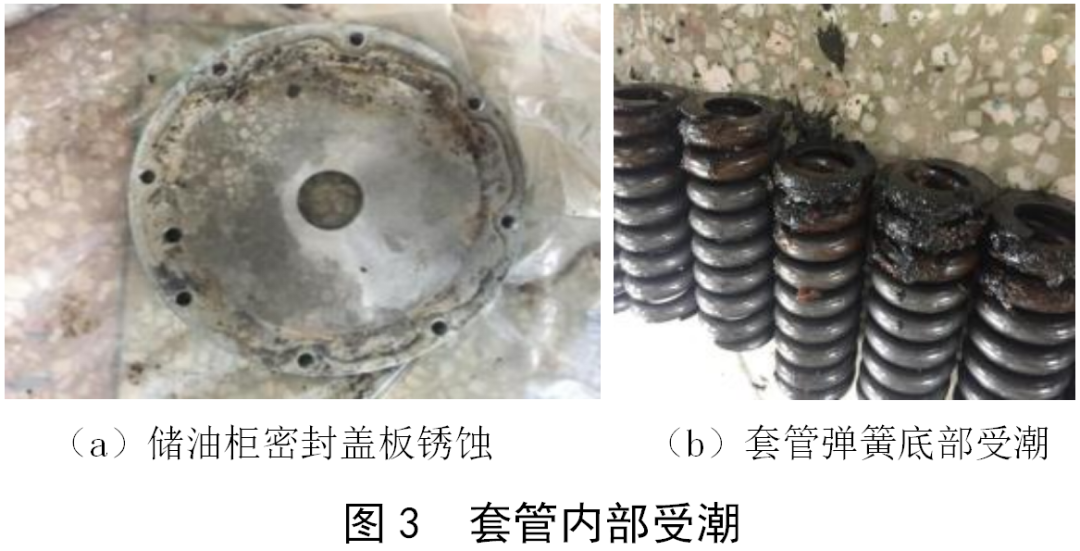
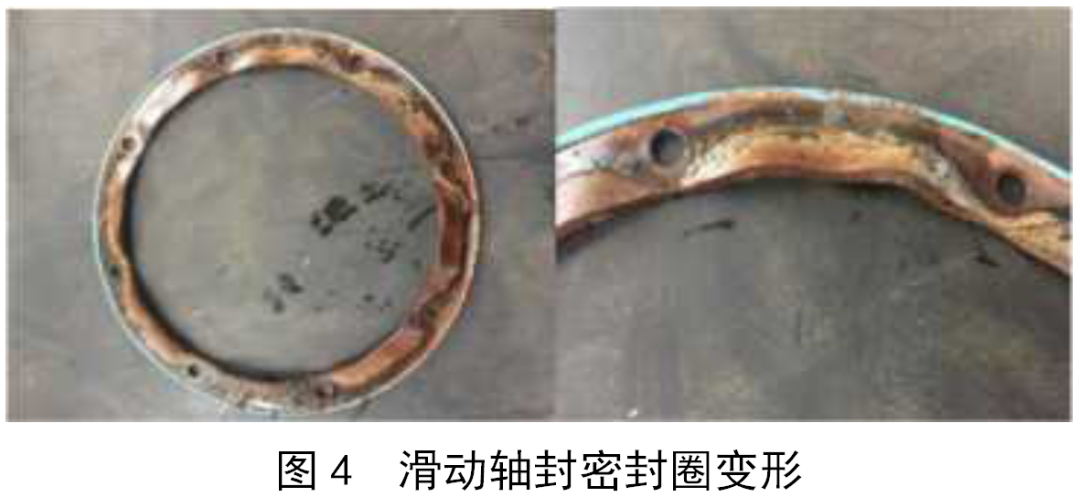
3 Conclusions and Suggestions
1) In the production and manufacturing process in the factory, the owner must organize technical personnel to carry out factory supervision and handover acceptance of the main transformers, and simultaneously carry out metal analysis testing in the factory and other technical supervision work. Detailed issues related to product quality and abnormal data found during testing must be carefully analyzed and carefully rectified. During handover and acceptance, information such as the material model, electrical test data, and factory records of the same batch of casings from the manufacturer must be collected.
(2) The on-site acceptance after the installation of the main transformer must be carried out carefully, and any possible doubtful points must be checked for any part of the main body and components. Special personnel should be assigned to conduct on-site supervision to ensure that the quality of casing installation is qualified. Before the transformer is put into operation, an oil test should be arranged to discover and deal with equipment hazards in a timely manner.
(3) During the operation of the main transformer, casing defects can be compared horizontally and vertically through electrical tests, oil tests, infrared temperature measurements and other means, and equipment defects can be presented through key test data Characteristics and changing trends. Through comprehensive analysis and judgment, the hidden dangers of the main transformer casing are diagnosed and the defects are accurately located.
(4) Before routine power outage maintenance of the main transformer, live inspection of each component should be arranged to promptly discover defects such as lack of oil or moisture in the casing, and a maintenance plan should be formulated in advance to ensure that the maintenance is completed in one step. Improve the quality of maintenance.